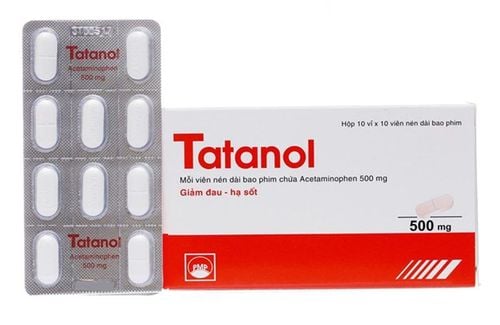This is an automatically translated article.
Paracold is a drug commonly used in pain relief, antipyretic due to flu, inflammation. Compliance with indications and doses of Paracold will help patients improve treatment effectiveness and ensure safety for health.
1. Uses of Paracold 500mg
Paracold is a pain reliever, antipyretic, is made in the form of effervescent tablets with the main ingredient in each tablet is Paracetamol 500mg.
Paracetamol is a non-steroidal antipyretic analgesic. Paracetamol is the active metabolite of Phenacetin, it is an effective analgesic and antipyretic that can replace Aspirin. However, unlike Aspirin, Paracetamol has no anti-inflammatory effect. Paracetamol has the same analgesic and antipyretic effects as aspirin in equal doses in grams.
With therapeutic doses, Paracetamol has little effect on the cardiovascular and respiratory systems, it does not change the acid - base balance, does not cause irritation, ulcers or stomach bleeding like Salicylates. Since Paracetamol has no effect on systemic cyclooxygenase, it acts only on central nervous system cyclooxygenase/prostaglandin. Paracetamol does not have the same effect on platelets or bleeding time as aspirin.
Paracold 500 mg is indicated in the following cases:
Pain relief in the following cases: Nerve pain; Headache ; Athritis; Pain due to trauma; Backache; Dysmenorrhea ; Toothache, ... Reduce fever due to flu, infection. Paracold is contraindicated in the following cases:
People who are sensitive to any of its ingredients; People with anemia many times or have heart, lung, kidney, liver failure; Patients with glucose-6-phosphate dehydrogenase deficiency. Paracetamol in Paracold can cause serious skin reactions such as Stevens-Johnson syndrome (SJS), toxic epidermal necrolysis (TEN), Lyell and exanthematous syndrome with caution when using Paracold. acute generalized pustulosis (AGEP); Use caution when using Paracold for patients with pre-existing anemia; Do not drink alcohol while taking Paracold; In case of salt diet, it should be noted that Paracold contains 416mg Na/tablet; If the pain persists for more than 5 days, the fever persists for more than 3 days, or the medicine is not effective enough, or you notice other symptoms, do not prolong the use of Paracold without consulting. doctor.
2. Dosage and how to use Paracold 500mg
Paracold is taken orally, it should be taken with a glass of water. Dosage of Paracold should be according to the doctor's prescription, the reference dose for specific cases is as follows:
Adults and children over 12 years old: Use a dose of 500 - 1000mg / time every 4-6 hours as needed. necessary but not more than 4g/day; Children from 6 to 12 years old: Use a dose of 250 - 500mg / time every 4-6 hours as needed, up to 4 times / day; Do not arbitrarily use Paracold for pain relief for more than 10 days for adults and more than 5 days for children; Do not arbitrarily use Paracold to reduce fever in cases of fever that is too high (above 39.5°C), persists for more than 3 days, or fever recurs. Paracold overdose can be caused by taking a single high dose, taking repeated high doses of Paracold (7.5 - 10g per day, within 1-2 days) or by taking the drug for a long time. Hepatic necrosis is the most serious acute toxic effect of Paracold overdose and can be fatal. Symptoms of nausea, vomiting and abdominal pain usually appear within 2 to 3 hours after taking a high dose of the drug.
How to handle an overdose of Paracold:
Need to wash the stomach in all cases, preferably within 4 hours after taking Paracold and give active supportive treatment. Use antidotes with: N-acetylcysteine, Methionine. In addition, the doctor may use activated charcoal and/or salt bleach to reduce the absorption of Paracetamol.
3. Side effects of Paracold 500mg
During the use of Paracold 500 mg, you may encounter some side effects of the drug.
Skin rashes and other allergic reactions occasionally occur. Usually erythema or urticaria, but sometimes can be more severe and may be accompanied by drug fever, mucosal lesions. Less common side effects of Paracold include:
Nausea, vomiting; Hematopoietic disorders such as neutropenia, leukopenia, pancytopenia, anemia; Kidney disease, nephrotoxicity occurs with long-term abuse of the drug. Rare side effects of Paracold include:
Hypersensitivity reactions.
4. Interaction of Paracold with other drugs
Concomitant use of Paracold with Isoniazid, alcohol, anticonvulsants (such as Phenytoin, Barbiturates, Carbamazepine) may increase the risk of hepatotoxicity by Paracetamol; Concomitant use of Phenothiazines with Paracold may lead to the potential for severe hypothermia; Metoclopramide may increase the absorption of Paracetamol in Paracold. The article has provided information on what Paracold 500 mg has, dosage and notes when using it. To ensure safety for your health and maximize the effectiveness of your treatment, you need to take Paracold exactly as directed by your doctor, do not increase or decrease the dose or give prescriptions to others to use.
Please dial HOTLINE for more information or register for an appointment HERE. Download MyVinmec app to make appointments faster and to manage your bookings easily.













